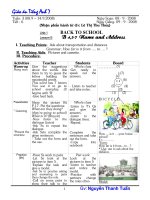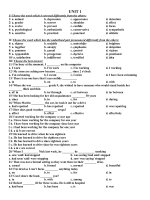UNIT 1: HOME LIFE (from period 1 to 5) doc
Bạn đang xem bản rút gọn của tài liệu. Xem và tải ngay bản đầy đủ của tài liệu tại đây (113.97 KB, 6 trang )
- 1 -
UNIT 1: HOME LIFE
(from period 1 to 5)
A – READING
OBJECTIVES
Aims: Family is a base from which we can go into the world with confidence. We should appreciate it
more than things.
Lexical items: Words / phrases related to home life.
Teaching aids: pictures in textbook.
Skills: Reading for gist and for specific information
METHOD: Integrated, mainly communicative.
PROCEDURE
Teacher’s Activities Students’ Activities
WARM-UP
T shows picture on page 12 and asks questions
1. Who do you think they are?
2. Where are they?
3. What are they doing?
4. How do you feel when you see such a warm and
peaceful scene?
BEFORE YOU READ
T can explain some new words
Work on (v): to spend time and effort doing something
Shift (n): one of the periods during each day and night
when workers in a factory, hospital etc do their work
Lab (n): informal a laboratory
Project (n): a piece of work that is carefully planned and
done over a period of time
as soon/quickly/much etc as possible : as … as you can
join hands (v): if two people join hands, they hold each
other's hands
responsibility (n) [For]: if something is your
responsibility, it is your job or duty to do it
household (n): all the people who live together in one
house Many households have at least one computer.
Run (v): control, organize, or operate a business,
organization, activity etc
make sure (that): to check that something is true or that
something has been done Can you make sure the door's
locked?
Rush (v) [to]: to move or go somewhere quickly [= hurry]
By the time (adv): when
give somebody a hand (with something): to help
someone, especially by carrying or lifting things
lend a hand (with something): to help someone,
especially when there are not enough people to do
something
dish (n): food cooked or prepared in a particular way a
wonderful pasta dish
eel (n): [countable] a long thin fish that looks like a snake
attempt (n) [countable] : when you try to do something
eldest (a): especially British English the eldest child in a
family is the oldest one
chore (n) [countable] a job that you have to do, especially
a boring one
somebody is to do something: formal - used to say what
must happen: You are not to go out / used to say what
will happen They are to be married in June.
look after somebody/something (phrasal verb): to take
care of someone or something
mischievous (a): a mischievous child behaves badly, but
in a way that is not serious
obedient (a): someone who is obedient does what a
person, law, or rule tells them to do [
≠ disobedient]
close-knit (a) also closely-knit: a close-knit family or
Students’ answers may vary
Whole class
- 2 -
group of people know each other well and help each other
a lot
come up (v): if a problem comes up, it suddenly happens
base (n): the main place where someone works or stays,
or from which work is done The firm has its main base
in London.
WHILE YOU READ
T asks Ss to read the text silently and guess the
unknown words while reading.
T asks Ss to do task 1 in the textbook
T has Ss compare their answers with their partners’
T conducts the correction of task 1
T has Ss read the text again and answer the questions
in task 2.
T walks round the class, offers ideas and comments
when Ss need help.
1. How busy are the parents in the passage?
2. How caring is the mother?
3. How do the father and the daughter share the household
chores?
4. What does the daughter of the family attempt to do
after secondary school?
5. Why do the children feel they are safe and secure in
their family?
T has Ss compare their answers with their partners’
T conducts the correction of task 2
AFTER YOU READ
T has Ss sit in groups of four or five, tell their
partners about his/her family life about their family.
T has a representative of each group report their
group’s ideas in front of the class.
T explains the some phrases (to take care of one
another, share household chores, obey family’s rules)
T assigns homework.
Ss read the text and give answers to task 1
Answers
1 2 3 4 5
B C A B A
Ss read the text again and give answers to
task 2
Answers
1. Very busy. They have to work long
hours and sometimes they have to work at
night.
2. She is always the first one to get up in
the morning to make sure that her children
leave home for school with breakfast and
in suitable clothes. She always makes
dinner ready before her husband comes
home.
3. The daughter helps with the household
chores: She washes the dishes and takes
out the garbage. She also looks after the
boys/her younger brothers. The father
sometimes cooks/does some cooking or
mending things around the house at
weekends.
4. She attempts to win a place at university.
5. Because they are very close knit and
supportive of one another. They often share
their feelings and whenever problems come
up, they discuss them frankly and find
solutions quickly
Ss work in groups.
Homework: learn new words
Comments
B – SPEAKING
OBJECTIVES
Aims: By the end of the lesson, Ss will be able to use the notes to talk about family life.
Lexical items: Words / phrases related to family life.
Teaching aids: handouts
Skills: Ss can talk about one’s family life.
METHOD: Integrated, mainly communicative.
PROCEDURE
Teacher’s Activities Students’ Activities
WARM-UP
T asks Ss some questions
1. Who does household chores in your family?
2. Do you often help your mum/dad with the housework?
BEFORE YOU SPEAK
T has Ss read the sentences in task 1 and tick () the
ones that apply to you and your family.
T explains some new words
Ss’s answers may vary
Ss work in pairs
Whole class
- 3 -
work (v): to do a job in order to earn money
share household chores : do housework with other
people
share an interest: to have the same interests, opinion etc
as someone else
share personal secrets: to tell someone else about
personal secret
T has some Ss talk about their family.
WHILE YOU SPEAK
T explains the differences between two types of
questions.
T has Ss work in pairs and make questions from the
words given in task 2.
T checks whether Ss can make correct question
T: Work
T: Household chores
T: Responsibility
T: Interest
T: Secrets
T: Important decision
T has Ss use the questions they have formed to ask
their partner about his/her family life and ask them to
note down the answers in the table.
T walks round the class, offers ideas and comments
when Ss need help.
AFTER YOU SPEAK
T has Ss get back to their original pairs and tell each
other the information they have collected.
T assigns homework.
Whole class
Ss work in pairs to make questions.
S: Who works in your family?
S: Who does the household chores in your
family?
S: What is your responsibility in the
family?
S: What interest do your family members
share closely?
S: Who do you share your secret with?
S: Who do you talk to before making an
important decision?
Ss do task 3
Example: I talked to Tam. Both his parents
work. But only his mother does the
household chores. …
Homework: learn new words
Comments
C – LISTENING
OBJECTIVES
Aims: By the end of the lesson, Ss will be able to listen to two people talking about their family life
Lexical items: Words / phrases related to family life
Teaching aids: pictures, a tape/CD, and handouts
METHOD: Integrated, mainly communicative.
PROCEDURE
Teacher’s Activities Students’ Activities
WARM-UP
T asks some questions
1. What’s happening in the picture?
2. How many people are there? Who are they?
3. How are they feeling?/How do they look?
BEFORE YOU LISTEN
T explain some new words
flight (n): a journey in a plane, or the plane making a
particular journey
book (v): to arrange to have or do something at a
particular time in the future She booked a flight.
reserve (v): book
after all: used when saying something that shows why
you are right/used to say that what you expected did not
happen
coach (n): a bus with comfortable seats used for long
journeys [= bus American English]
spread out (v): if a group of people spread out, they move
apart from each other so that they cover a larger area:
end up (v): to finally be in a particular place, situation,
or state without intending to
Ss answer the questions
Whole class
- 4 -
leftovers (n): food that has not been eaten during a meal
crowded (a): very full of people or things
rarely (adv): not often
T has Ss listen and repeat the words on page 16
WHILE YOU LISTEN
T: Listen to Paul and Andrea talking about their
family life and decide whether the statements are true
(T) or false (F).
T has Ss skim through the sentences and try to guess
whether they are true or false.
T asks Ss look at the statements on page 16. Then T
has Ss listen to the conversation and decide whether
they are true or false.
T has Ss sit in groups and compare their answers with
their partners’
T asks some Ss write the answers on the board and
ask “why do you choose it is true/false?
T conducts the corrections.
T has Ss listen to the conversation again and note
down two things that are different about their
families.
T has Ss sit in pairs and compare their answers with
their partners’
T conducts the corrections.
AFTER YOU LISTEN
T has Ss talk about their families.
1. How many people are there in your family? Who are
they?
2. Do all members of your family live together?
3. Do they often get together on special occasions?
4. Do you have a big meal together?
………….
T assigns homework.
Ss read the sentences quickly and make a
guess before listening.
Ss listen to the conversation twice and
decide whether they are true or false.
Ss check their corrections.
Answers:
1 2 3 4 5
F F F T T
Ss listen to the conversation three times.
Answers:
Paul Andrea
His family
members are not
very close
He is a close knit
family.
The family often
eat the meal the
mother cooks at
home
The family often
go out to eat when
they get together.
Homework: learn new words
Comments
D – WRITING
OBJECTIVES
Aims: By the end of the lesson, Ss will be able to write a letter to a pen pal about their family rules.
Lexical items: Words / phrases related to family rules such as let, allow, be allowed to, have to, permit,
ect.
Teaching aids: handouts
METHOD: Integrated, mainly communicative.
PROCEDURE
Teacher’s Activities Students’ Activities
WARM-UP
T asks some questions
1. What are you allowed to do at home?
2. What are you allowed to do at school?
BEFORE YOU WRITE
T asks Ss to discuss and add other family rules
T expains verbs and expressions in task 1
Allow is used in both formal and informal English
Ex: You're not allowed to wear earrings to school.
Let is informal and is used a lot in spoken English
Ex: Will your Mum let you come to the party?
Permit is formal and is mainly used in written English
Ex: Smoking is not permitted in this building.
Have got to is more informal than have to and is used
Ss work in groups
Whole class
- 5 -
especially in spoken English, often to emphasize how
important something is
Ex: You've got to believe me!
T raises some questions like these:
1. Where and how do you write the address and the date?
2. How many parts are there in the letter?
3. What transitions can we use?
4. How do we end the letter?
WHILE YOU WRITE
T ask Ss to use the ideas they have discussed above to
write a letter to a pen pal about their family rules.
Begin as follows.
T walks around the class, helping Ss if they have any
problems with their writing and note down the most
common mistakes Ss make in order to correct in front
of the class.
AFTER YOU WRITE
T checks how Ss have corrected their mistakes, then
give marks to some of them.
T assigns homework.
Answer:
3/4/2001
Four parts
first, second, next, moreover, in addition,
last, in short
love …
Ss write the letter, then listen to the teacher
pointing out the most common mistakes
and look at their own writing. If they are
their own mistakes, try to correct them.
Homework: Rewrite the letter and send it
to his / her friend.
Comments
E – LANGUAGE FOCUS
OBJECTIVES
Aims: By the end of the lesson, Ss will be able to pronounce the ending “S” and use three tenses (past
simple, past progressive and present perfect)
Lexical items: Time expressions (yesterday, ago, since, for, ect.)
Teaching aids: a tape/CD, and handouts
METHOD: Integrated, mainly communicative.
PROCEDURE
Teacher’s Activities Students’ Activities
PRONUNCIATION
The pronunciation of the ending ‘s’
After a vowel sound or voiced consonant we
pronounce the final –s /z/
After a voiceless consonant (/t/, /p/, /k/), we
pronounce the final –s /s/
When the word ends in –ges, -ches, -sses, -ses, or
shes, we pronounce –es /iz/
Play the tape
Play the tape again
GRAMMAR
T explains grammar points
1. Past simple
Spelling
1.1 The normal rule is to add –ed (worked / started)
If the verb ends in –e, add –d (lived / loved)
1.2 If the verb has only one syllable + one vowel + one
consonant, double the consonant. (stopped / planned)
1.3 If the verb ends in a consonant + -y, change the –y to
–ied (studied / carried)
Form
V-ed / V2 didn’t + V Did + S + V?
was / were wasn’t/weren’t Was / Were + S …….?
Use
1.1 The past simple expresses a past action that is now
finished.
1.2 Notice the time expressions that are used with the past
simple (last year / ago / yesterday / in 1995, ect.)
2. Past progressive
Form
Was/were + V-ing
Use
Ss listen and pay attention to the ending ‘s’
Ss listen and repeat
Exercise 1:
1. Have you seen
2. did you enjoy
3. was
4. Did you give
5. didn’t listen
6. Have you two met
7. Did you met
Exercise 2:
1. B
2. C
3. A
4. A
5. B
6. B
7. B
8. C
9. B
10. C
- 6 -
2.1 The past progressive expresses a past activity that has
duration.
I met her while I was living in Paris.
You were making a lot of noise last night.
What were you doing
2.2 The activity began before the action expressed by the
past simple.
She was making coffee when we arrived
When I phoned Simon he was having dinner.
2.3 The past progressive expresses an activity in progress
before, and probably after, a time in the past.
When I woke up this morning, the sun was shining.
What were you doing at 8.00 last night.
PAST SIMPLE VS PAST PROGRESSIVE
The past simple expresses past actions as simple facts
I did my homework last night.
“What did you do yesterday evening?”
“I watched TV.”
The past progressive gives past activities time and
duration. The activity can be interrupted.
“what were you doing at 8.00?” “I was watching TV
In stories, the past progressive can describe the scene.
The past simple tells the action.
It was a beautiful day. The sun was shining and the
birds were singing, so we decided to go for a picnic.
We put everything in the car …
The questions below refer to different time periods.
The past continuous asks about activities before, and the
past simple asks about what happened after.
3. Present perfect.
3.1 The present perfect refers to an action that happened
some time before now.
She’s travelled to most parts of the world.
Have you ever been in a car accident?
3.2 If we want to say when these actions happened, we
must use the past simple.
She went to Russian two years ago.
I was in a crash when I was 10.
ever / never
We use ever in questions and never in negative sentences
yet / just
we use just in possitive sentences. We use yet in negative
sentences and questions
been / gone
She’s gone to Japan. (and she’s there now)
She’s been to Japan. (somtime in her life, but now she has
returned)
T assigns homework.
11. B
12. C
12. C
14. A
15. B
MORE EXRCISE
MY AUNT NANCY
My aunt Nancy (1. be) born in England,
but now she (2. live) in Perth, Australia.
She (3. go) to Australia in 1985 when her
husband, my uncle Jack, (4.die)
.She (5. be) 80 years old now, but she still
(6. work). she is an artist. She (7. paint)
pictures of cats for birthday cards. She (8.
love) cats – she(9. have)
twenty-five cats.
She (10. start) painting in 1986. At first she
(11. paint) just for a hobby, but then in
1989 she (12. begin) making and selling
birthday cards. A lot of people (13. like)
them and (14. buy) them.
She usually (15. start) work at 7.00 in the
morning and (16. finish) at 5.00 in the
evening. Then she(17.go) swimming.
Last year I (18.visit) Australia and I (19.
stay) with her for two weeks. I (20. have)
a very good holiday
MONIKA KOVAK - Tennis player
Monika Kovak is a tennis player. She is
only 14 years old, but she (1. already / win)
many tournaments in her life. She (2. start)
playing tennis with her father when she
was three years old. Two years ago she (3.
go) to America to a famous tennis school in
California.
Monika and her father (4.travel)
to many countries. Last month they (5. go)
to a tournament in Australia. Monika (6.
play) well, but she (7. not win)
. She (8. not play)
at Wimbledon yet, but she hopes to play
there next year.
Comments







![Tài liệu [Luyện thi tiếng Anh] Unit 1&2: Tenses docx](https://media.store123doc.com/images/document/13/ce/wu/medium_wum1387768536.jpg)

